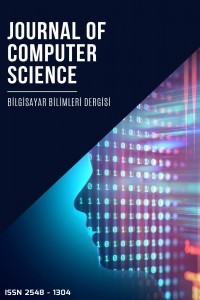Sınıflandırma Algoritmalarına Dayalı VGG-11 ile Yüzde Duygu Tanıma
Vgg-11, yüz duygu tanıma, fer2013
Facial Emotion Recognition With VGG-11 Based On Classification Algorithms
Vgg-11, facial emotion recognition, fer2013,
___
- Mahmoudi MA, Chetouani A, Boufera F, Tabia H. (2020) Improved Bilinear Model for Facial Expression Recognition. Communications in Computer and Information Science, 1322 CCIS, pp.47-59.
- Bouzakraoui MS, Sadiq A, Alaoui AY (2020) Customer satisfaction recognition based on facial expression and machine learning techniques. Advances in Science, Technology and Engineering Systems 5(4):594–599.
- Mukhopadhyay M, Pal S, Nayyar A, Pramanik PKD, Dasgupta N, Choudhury P. (2020) Facial Emotion Detection to Assess Learner’s State of Mind in an Online Learning System. ACM International Conference Proceeding Series, pp.107-115.
- ShanthaShalini K, Jaichandran R, Leelavathy S, Raviraghul R, Ranjitha J, Saravanakumar N (2021) Facial Emotion Based Music Recommendation System using computer vision and machine learning techiniques. Turkish Journal of Computer and Mathematics Education (TURCOMAT) 12(2):912–917.
- Gao Z, Zhao W, Liu S, Liu Z, Yang C, Xu Y (2021) Facial Emotion Recognition in Schizophrenia. Frontiers in Psychiatry.
- Simcock G, McLoughlin LT, Regt TD, Broadhouse KM, Beaudequin D, Lagopoulos J, Hermens DF (2020) Associations between Facial Emotion Recognition and Mental Health in Early Adolescence. International Journal of Environmental Research and Public Health 17(1).
- Zahara L, Musa P, Prasetyo Wibowo E, Karim I, Bahri Musa S. (2020) The Facial Emotion Recognition (FER-2013) Dataset for Prediction System of Micro-Expressions Face Using the Convolutional Neural Network (CNN) Algorithm based Raspberry Pi. 5th International Conference on Informatics and Computing (ICIC 2020).
- Khaireddin Y, Chen Z (2021) Facial Emotion Recognition: State of the Art Performance on FER2013.
- Shafira SS, Ulfa N, Wibawa HA, Rismiyati. (2019) Facial Expression Recognition Using Extreme Learning Machine. ICICOS 2019 - 3rd International Conference on Informatics and Computational Sciences: Accelerating Informatics and Computational Research for Smarter Society in The Era of Industry 4.0, Proceedings.
- Daihong J, Yuanzheng H, Lei D, Jin P (2021) Facial Expression Recognition Based on Attention Mechanism. Scientific Programming.
- Dong TN, Van L, Bao PT (2021) Facial Expression Recognition Using Multi-deep Convolutional Neural Network Encoders with Support Vector Machines. International Journal of Machine Learning and Computing 11(5):345–349.
- Mollahosseini A, Chan D, Mahoor MH. (2016) Going deeper in facial expression recognition using deep neural networks. 2016 IEEE Winter Conference on Applications of Computer Vision, (WACV 2016).
- Simonyan K, Zisserman A. (2014) Very Deep Convolutional Networks for Large-Scale Image Recognition. 3rd International Conference on Learning Representations, ICLR 2015 - Conference Track Proceedings.
- Gan Y, Yang J, Lai W. (2019) Video object forgery detection algorithm based on VGG-11 convolutional neural network. Proceedings - 2019 International Conference on Intelligent Computing, Automation and Systems (ICICAS 2019), pp.575–580.
- Wu M, Ma W, Li Y, Zhao X. (2020) The Optimization Method of Knowledge Distillation Based on Model Pruning. Proceedings - 2020 Chinese Automation Congress (CAC 2020), pp.1386–1390.
- Goodfellow IJ, Erhan D, Carrier PL, Courville A, Mirza M, Hamner B ve ark. (2013) Challenges in Representation Learning: A report on three machine learning contests. Neural Networks 64:59–63.
- Breiman L (2001) Random Forests. Machine Learning 2001 45(1):5-32.
- Siji George CG, Sumathi B (2021) Genetic Algorithm Based Hybrid Model Of convolutional Neural Network And Random Forest Classifier For Sentiment Classification. Turkish Journal of Computer and Mathematics Education (TURCOMAT) 12(2):3216–3223.
- Ooka T, Johno H, Nakamoto K, Yoda Y, Yokomichi H, Yamagata Z (2021) Random forest approach for determining risk prediction and predictive factors of type 2 diabetes: large-scale health check-up data in Japan. BMJ Nutrition, Prevention & Health.
- Cortes C, Vapnik V (1995) Support-vector networks. Machine Learning 20(3):273–297.
- Cervantes J, Garcia-Lamont F, Rodríguez-Mazahua L, Lopez A (2020) A comprehensive survey on support vector machine classification: Applications, challenges and trends. Neurocomputing 408:189–215.
- Saigal P, Khanna V (2020) Multi-category news classification using Support Vector Machine based classifiers. SN Applied Sciences 2(3):1-12.
- Cover TM, Hart PE (1967) Nearest Neighbor Pattern Classification. IEEE Transactions on Information Theory 13(1):21-27.
- Taunk K, De S, Verma S, Swetapadma A. (2019) A brief review of nearest neighbor algorithm for learning and classification. 2019 International Conference on Intelligent Computing and Control Systems (ICCS 2019), pp.1255–1260.
- Quinlan JR (1986) Induction of Decision Trees. Machine Learning 1:81-106.
- Bastos NS, Marques BP, Adamatti DF, Billa CZ (2020) Analyzing EEG Signals Using Decision Trees: A Study of Modulation of Amplitude. Computational Intelligence and Neuroscience.
- Liu S, Yang Z, Li Y, Wang S (2020) Decision tree-based sensitive information identification and encrypted transmission system. Entropy 22(2).
- Pedregosa F, Varoquaux G, Gramfort A, Michel V, Thirion B, Grisel O ve ark. (2011) Scikit-learn: Machine Learning in Python. Journal of Machine Learning Research 12(85):2825-2830.
- ISSN: 2548-1304
- Yayın Aralığı: Yılda 2 Sayı
- Başlangıç: 2016
- Yayıncı: Ali KARCI
Mehmet AKPAMUKÇU, Abdullah ATEŞ
Göğüs X-Ray görüntülerinin AlexNet tabanlı sınıflandırılması
Kubilay Muhammed SÜNNETCİ, Ahmet ALKAN, Edanur TAR
LSTM Öğrenme modeliyle COVID-19 Tweetleri üzerinde Duygu Analizi
Yunus Emre KARACA, Serpil ASLAN
Konu benzerliğine dayalı makale tavsiye sistemi
CT Görüntülerinden Covid-19 Tespiti için CNN Tabanlı Bir Yöntem
Dengeli Dağılım Sergilemeyen Dermoskopik Görüntü Veri Seti Üzerinde CNN Modelleri Karşılaştırma
Hüseyin FIRAT, Murat UÇAN, Davut HANBAY
Veri madenciliği yöntemleri kullanarak yoğun bakım ünitesindeki hastaların sınıflandırması
Emine COŞKUN, Esra GÜNDOĞAN, Mehmet KAYA, Reda ALHAJJ
Çağlar GÜRKAN, Merih PALANDÖKEN
Derin Öğrenme Yöntemleri ile Sıcaklık Tahmini: Diyarbakır İli Örneği
